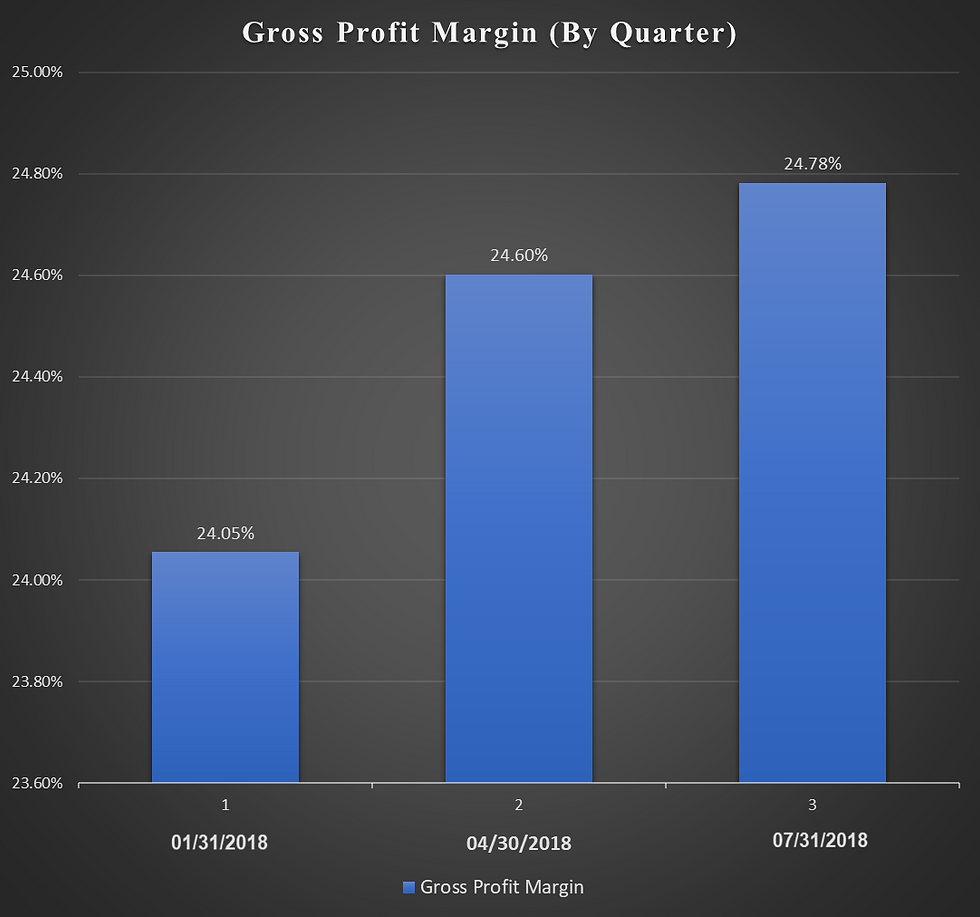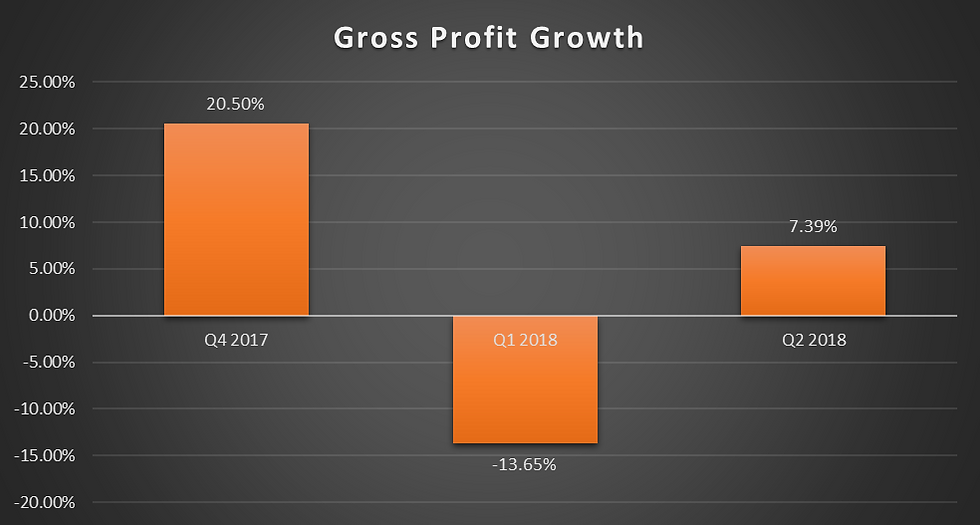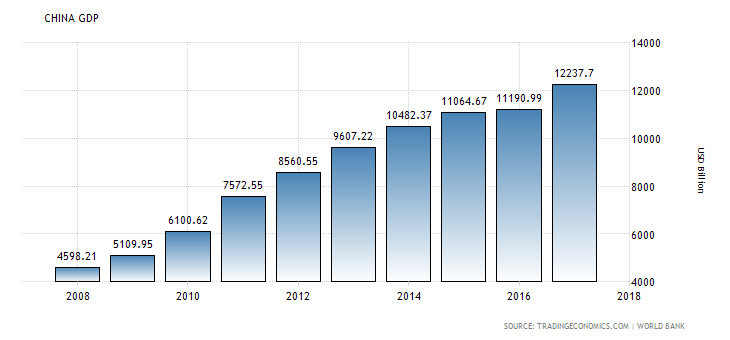Equities - November 2018
- Soham Mukherjee
- Nov 11, 2018
- 10 min read
Retail Sector: Who’s Leading Anyway?
Target Vs. Walmart
Written By:
Gunnar Gale
Matt Gasanov
Debjyoti Ghosh
Saem Jeon
Helene Lewkowicz
Winnie Lin
Noah Mamane
Taylor Munn
Jordan Non
Company Overview (Target)
Target is one of the leading brands among everyday low pricing companies. They have been one of the top retailers in their industry for decades, but they are beginning to get eclipsed by the growth of Amazon and other online shopping services. Now, Target and Walmart are fighting for business in the upcoming holiday season, both of whom are competing even more with Amazon. To try and combat the 2-day shipping service offered by amazon, Target is now beginning to offer 2-day shipping on any product, for any buyer, as well as same-day shipping for thousands of products, however that is for members only.
These efforts are translating with their traffic and profits over the last quarter. Target experienced a 6.4 percent growth in traffic last quarter, which came with a 6.5 percent increase in profits. This growth in traffic is the highest it’s been for Target since they began reporting traffic in 2008. The company also reported a 22.7 percent increase in GAAP (Generally Accepted Accounting Principles) EPS (Earnings per Share) after the second quarter of 2018.
Company Overview (Walmart)
Walmart, founded by Sam Walton, is a retail corporation that manages a chain of hypermarket, discount department stores, and grocery stores in several countries. When Walmart was founded in 1962, the store had only 1 location however that has quickly expanded to over 11,000 store locations globally. Now the largest retailer in the world, Walmart caters to shoppers who are looking for the best deals around; hence their slogan “Save Money. Live Better”. The corporation is involved in both the wholesale and retail business. In the 2017 fiscal year, Walmart reported a $485.8 billion in total revenue and $124.6 billion in gross profits, as well as $198.8 billion in total assets. The 2018 fiscal year is looking positive for Walmart as trends predict a $500.3 billion in total revenue as well as $204.5 billion in total assets.
Analysts of Walmart say that the company has booming momentum making it able to compete with Amazon. Analyst, Robert Drbul, believes every reason to be positive on Walmart and its opportunity for the future, as the business is in good shape. In Q2 Walmart reported a 40% growth on their e-commerce platform and an inventory decrease by 3.4%. This means that Walmart is quickly moving inventory which is good for the company’s profitability.
Sector:
Walmart and Target are both in Consumer Defensive sector and Discount Stores industry. Companies in Consumer Defensive Sector are engaged in the consumer staples, such as manufacturing of food, beverages, household and personal products, packaging, and tobacco. Consumer staples are the products that people always demand and are willing to spend money on no matter how their financial situations are. Other companies in this sector are Philip Morris International and Procter & Gamble.
Consumer Defensive Sector is also called Consumer Non-Cyclical Sector, meaning there is a low correlation between its price and economic activities. Consumer Cyclical Sector, on the other hand, has a high correlation between its price and economy. In other words, Non-Cyclical Sector is not easily affected by economic recession while Cyclical Sector tends to drop its price when economy is in recession. One of the examples of Consumer Cyclical Sector companies is Amazon.
Walmart Current Event
In the beginning of the year, Walmart had the largest acquisition in its history by acquiring Indian e-commerce company Flipkart. However, this large acquisition did not seem to bring immediate profit to the company and Walmart lowered its target EPS goal from the range between $4.90 to $5.05, to $4.65 to $4.80. Walmart claimed that it would be a long-term process contribution towards the company, which would result in slightly depressed earnings in the short term.
As we approach the holiday season, Walmart has implemented strategies to increase the efficiency for customer to have a better shopping experience both in the store and online. The company introduced new technology such as Check Out with Me, a check out system to checkout with the associates instead of waiting in checkout line. Also, Store Map, an app to find where the product is allocated in the store. For online service, both Target and Walmart are offering two-day free shipping. It indicates how competitive the two companies are as we move towards the most profitable season as both races to increase sales and profits.
Current Events Target
Target has announced that it will launch “Skip-the-Line” checkout technology which customers will be able to pay for the products instantly through sales associates. This technology is like Walmart’s “Checkout with Me” technology. Target published its Black Friday advertisements and some deals are already available on televisions and video games. Starting November 21, there will be more than 100 Black Friday deals. These promotions may have a big impact on Target’s sales, according to Deloitte’s holiday survey where 82% of the customers said that promotions affect their shopping habit.
The bankruptcy of Toys “R” Us opened a large space for other retail stores to enter the market. Toys “R” Us accounted for 20% of the market before it went bankrupt. Target dedicated nearly a quarter of a million square feet of new space to its toy business across 500 stores, nearly double the space it dedicated last year. The customers will be able to shop for more than 2500 new and exclusive toys.
“Last year, Target acquired Shipt, a same-day delivery startup, for 550 million dollars. This increased Target’s efficiency in providing same-day delivery in its stores. Even though it is mostly limited to essential products for now, Target aims to widen its faster delivery services to all product categories. Target commented that the acquisition won’t affect the financial results in the short term but will cause a significant increase in profits in the long term as same day-delivery product categories widen by 2020.
Retail Market Performance
One of the most important features of the current market situation in the retail branch is depicted in a huge, gradual and multifaceted transition to innovation and technologies — every company in this sphere tries to adopt new ideas and to make their firm a leader in the tech-oriented part of the business. However, nothing can depict market performance better than the stock levels themselves.
We selected 3 of the most influential companies in the retail market, — Walmart, Amazon and Target, — and attempt to find a reasonable explanation for the reasons of their current and past indicators.
I. Walmart’s Last Month Performance

For the last month Walmart’s stock price has risen by 6.82%, while the S&P 500 Index is down by 6.33%, evidencing the fact that financial markets now are experiencing hard times.
II. The Last 3 Months of Walmart’s Stock Price

If we analyze the last 3 months of Walmart’s stock price, we will realize that during that period, the stock price has increased by 13.10%. This is the main factor behind Walmart’s strong position in the retail market

III. The Last Month Performance of Target
The result of -0.85% in the stock price vividly reveals the current position of the company — it’s not so bad as it is still better result than financial markets in general, but it’s also not as strong as its main competitor — Walmart

IV. The Last 3 Months of Walmart’s Stock Price
Despite the in-negative final sign of the marginal cost, we cannot come to a positive conclusion in this case, as the growth number is only 3.43% — which is 9.67% less than Walmart’s indicator
V. The Last 3 Months of Amazon’s Stock Price

As one of the largest threats for traditional brick-and-mortar retail stores as Walmart and Target are, Amazon is also an important indicator of retail branch performance in general. Following general trends in the financial markets, Amazon’s price per stock is down for 9.86% for the last 3 months. However, it also can be a result of a plethora of other reasons and events surrounding Amazon — that’s why this indicator is rather relative and cannot be fully considered to be indicator of the whole market.
Economic Conditions
The winning streak of major US stock exchanges has finally reached the finale, purported to be called ‘Red October’.
After several months of quietly sailing to new highs, U.S. stock indexes took a sudden fall in October. The Dow Jones Industrial Average closed 6%. The S&P 500 Index fell 7%. The tech-heavy Nasdaq Composite was hit hardest, declining 9% in October. More stocks closed in the red than saw gains. Of the 500 stocks in the S&P, nearly 400 saw declines.
While the losers were more common than stocks that saw gains, there were some notable winners. Walmart’s stock gained 7% during October, while Ross Stores rose 2% and Walgreens rose 10%. Many of these retailers cater to bargain-hunting consumers and could see a relative benefit if the economy slows down. One retailer that had a horrible month was Amazon, whose stock fell 20% during October and at one point had lost about $250 billion in value since its early September peak.
There were too main factors behind the U.S. stock selloff. First, concerns about rising interest rates, which not only make borrowing more expensive for companies, but also make bonds more competitive investments to stocks. Second, investors are also worried about the impact of a trade war between the U.S. and China, which showed signs of escalating during the past month.
Quarterly Analysis of Walmart Stores, INC.
The daily stock price ranging from 11/01/2017 through the present.

To compete with lucrative FANG stocks such as Amazon, with stock trading at 160 times earnings in September and various advances made in the form of growing subscription services as well as being the first to raise minimum wage to $15 per hour, brick-and-mortar retailers such as Walmart is divesting earnings into improving online operations to compete. The move has surely taken a toll on Walmart as, from the above chart, a net loss of 140% over previous quarter is glaringly visible. Furthermore, growth of revenue in the 2019 second quarter over massive losses indicate shrinking company margins. Similarly, adjusted Earnings per Share has grown to 13% from the negative earnings territory last quarter, irrespective of Walmart bearing losses this quarter. This sign is an intimation of massive share repurchases or creation of Treasury stock through dilution of outstanding shares, giving EPS a possible boost. It further explains the rise in cost, impacting Net Income margins.

In the fourth quarter of 2017, Walmart was subjected to restructuring charges and loss on maturity of debt. Furthermore, closure of numerous Sam’s Club (retail company operating under Walmart) along with a decision to exclude the sale of tobacco products from certain clubs impacted the January EPS by a surprise margin of around 2%. However, in the recent two quarters, Walmart has beat analyst estimates by considerable margins, indicating a greater portion of company’s profit stemming from each share of common stock. This is a sign of strong investor confidence amid reports of Walmart’s instability in the market.

In the domain of Gross Profit and Operating Income margin, Walmart has a competitive advantage. An exponential rate of growth can be observed over every quarter. Walmart’s dominance over these two important financial metrics, used to assess a company’s financial health and business model, reflects significant generation of profit from revenue to pay off variable costs of production (such as raw materials, wages) along with enough reserves to finance Cost of Goods Sold (COGS).
Selected corporate events that justify the sustained growth:
1. Investment in Flipkart Group
On Aug. 8, 2018, the Competition Commission of India issued an unconditional approval for the company's investment in Flipkart, which satisfies one of the conditions to the closing of the company's investment in Flipkart. The transaction is expected to close as soon as reasonably practicable after the satisfaction or waiver of the remaining closing conditions.
2. Sale of a majority stake in Walmart Brazil
On Aug. 1, 2018, the company completed the sale of an 80 percent stake in Walmart Brazil.

Walmart vs S&P 500
Target Analysis

With the revenue growing in the fourth quarter of 2017, due to the holiday season, it is of no surprise that the first quarter of 2018 is way below the mark that Q4 set. For the second quarter of 2018, profit, and revenue increased.
For the first quarter of 2018, revenue increased by 3.5% from the previous year, with an increase of foot traffic by 3.7%! Digital sales climbed 28% in the first quarter, thusly helping the revenue increase.

The missing of the EPS (Earnings per Share) mark was due to the poor spring weather. With the weather staying colder for longer, the spring purchases, like patio furniture, and grills, have not increased, thus decreasing their profit. Now, they still improved their foot-traffic, so this is a good sign, leading into the main spending time, holiday season. The first quarter of 2018 had Target missing earnings but beat its revenue expectation.

Its Q1 was much lower than experts expected, as Target made price cuts, higher wages, ad investments in its online businesses.
With the investment in its online business, it has emphasized its services in curbside pickup and home delivery.
The other thing to look forward to Target this upcoming quarter is its free shipping. Prior, Target has given free to orders of $ 35.00 or more to target members, now it is free shipping on every item, with no membership requirement. Attempting to compete with Amazon, and Walmart.

Now, even though people are entering into the Target stores at record numbers, same store sales missed the mark by 0.2%. Even though that may seem small, that difference means millions upon millions of dollars for Target.
What the Experts are Saying
Walmart will benefit in the future from the investments they have made recently: They have expanded their online grocery pickup, pickup towers, and grocery delivery services. The company has recently had the benefit of receiving a lower effective tax rate. Its growth rate, much like Target’s, is expected to be low in 2019.
Of 32 analysts asked to give their opinion on Walmart 19 replied with the decision to “hold” the stock. 13 replied to “buy” the stock.
Experts predict a stock price of $103-105 per share which would be more than a 5% growth.
Target has a strength in resonating among younger consumers for having “more hip” and “in” items and genuinely considered to have better products than Walmart. While this may be the thought of many, Target only has stores in the U.S. so for the time being it has no presence in the international markets. A time where this weakness could be truly exposed is during a recession. A continued crisis in the housing market would mean that most of Targets consumer base would have little disposable income. They would not be able to lean on their foreign sales to fall back on.
Target also insists on quality for their products which raise prices whereas their competitors (Walmart) do not necessarily stress that. It is being recommended that Target works on building an international network of stores if it hopes to compete with international companies in the future.
Analysts are beginning to become concerned with Target’s possibly unstable future and are recommending a “sell”
The overall conclusion that can be extracted from the above graphs and indicators is that the market itself currently is demonstrating not the most powerful conditions — most retail stores’ stock prices are down, and some of them significantly fell in price (such as Target). However, it also can be explained by the overall bad market conditions that are occurring now. So, we shouldn’t forget about the fact that several retail companies (such as Amazon or Walmart as the main competitor of Amazon) has a very strong potential of long-term growth because of their innovations and tech-basements. In this aspect, such companies as Target, which are not adjusting to modern competitive features, are probably doomed for even further fall in price and financial problems.






Comments